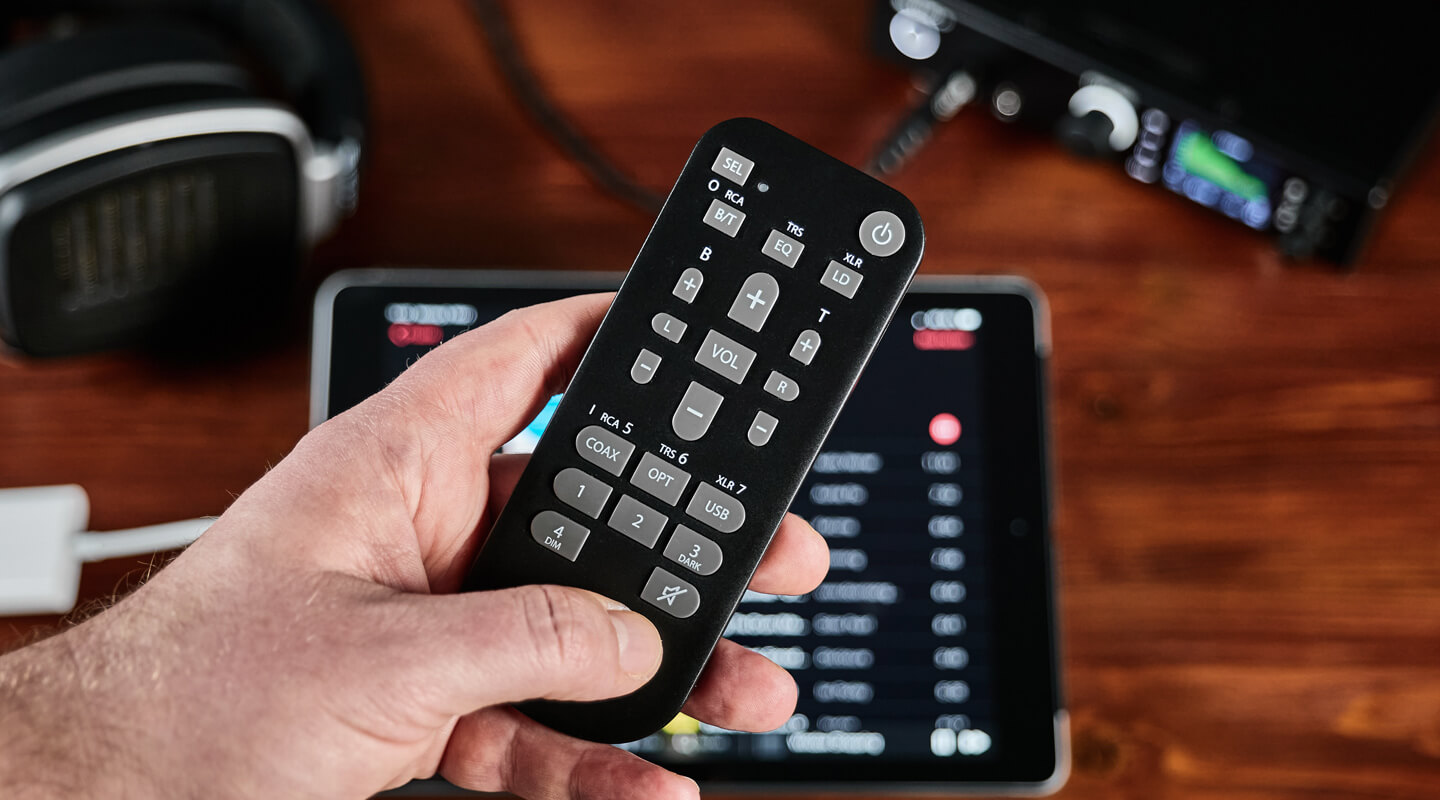ADI-2/4 Pro SE
2-AD/4-DA 768 kHz, High-Performance Converter
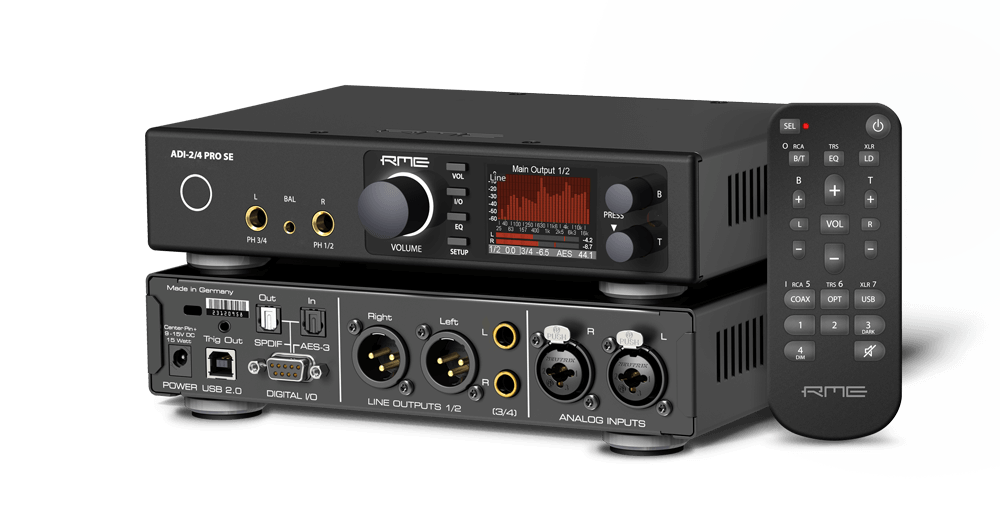
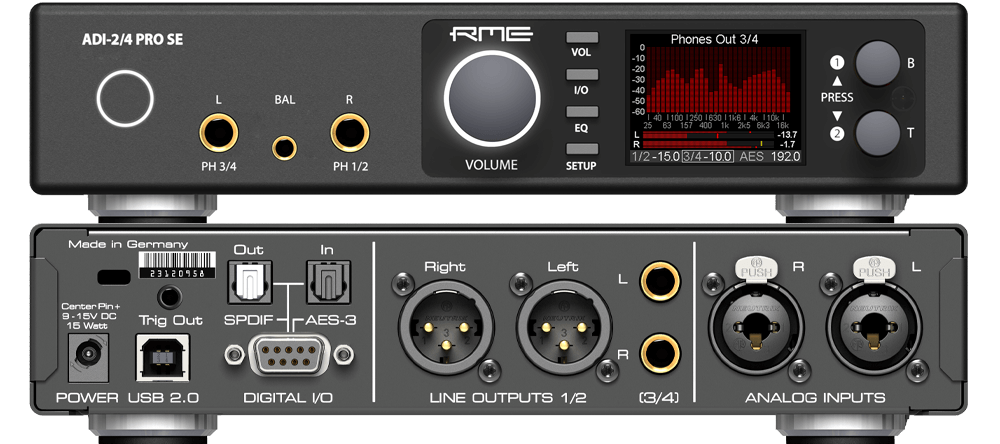
Connectivity and Features
RME's latest AD/DA converter is:
- A high-end AD/DA converter in professional studio quality
- A double headphone amplifier in true high-end quality
- A USB DAC like no other - the most versatile and capable one around
- A high-end AD/DA frontend and headphone amp for iPad and iPhone
- An AD/DA frontend for measurement systems at up to 768 kHz sample rate
- A multi-format converter (AES, SPDIF, ADAT) with monitoring
- An SPDIF/ADAT playback system
- A DSD record and playback solution
- A vinyl player digitizing solution on highest level
A Multitude of Devices compressed in one Housing
The ADI-2/4 Pro SE is a 2-channel analog input to digital and 4-channel digital to analog output converter in a half-rack (9.5") enclosure of 1 U height. Latest 32 bit / 768 kHz converters offer up to 123 dBA signal to noise ratio. Reference class tech specs throughout are combined with an unprecedented feature set. A powerful DSP adds all kinds of useful audio processing, including 5-band parametric EQ, fast Bass/Treble adjustment, Crossfeed, and a new concept in Loudness sound control.
The ADI-2/4 Pro includes two servo-balanced analog inputs on combo XLR / TRS jacks, two separate balanced and unbalanced outputs on XLR and TRS, two stereo Extreme Power headphone outputs on the front for easy balanced operation of all headphones, including IEMs via Pentaconn connector.
Also available are optical SPDIF I/O, which also understands ADAT, as well as coaxial SPDIF (RCA) and AES I/O (XLR) via an included breakout cable. This universal set of I/O options offers superior quality and flexible connectivity to those who take a no-compromise approach to audio.
With independent balanced outputs for Line and Phones, balanced phones no longer mutes the rear outputs. Balanced Line and Balanced Phones outputs can be used simultaneously, even with different sources/signals. The balanced TRS in the back can be fed from Line 1/2 or Phones 3/4 signal path, perfect for handling insert effects during the mastering process.
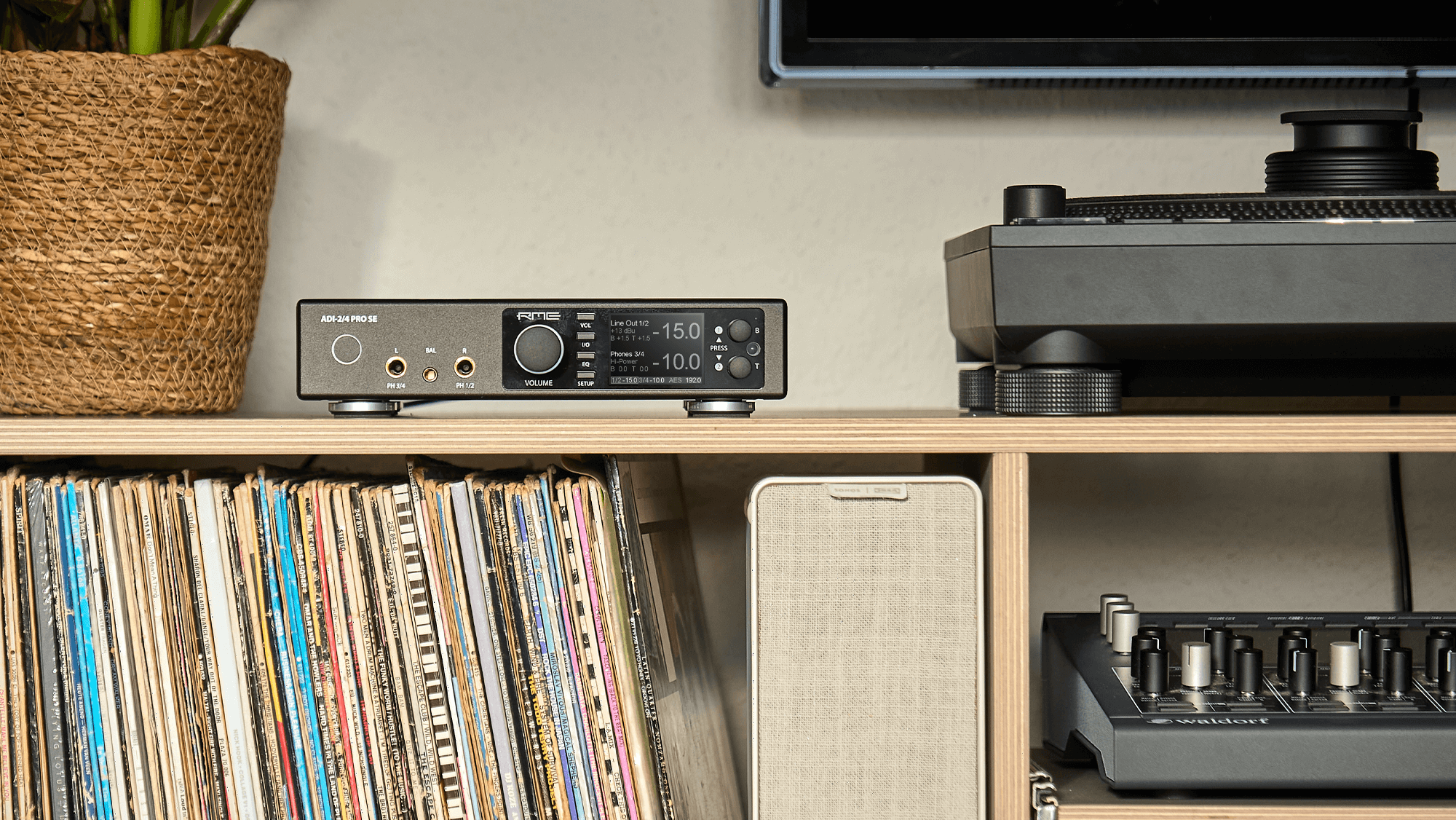
A high resolution IPS panel for the graphical operation surface eases operation even more, and displays further functions provided by the DSP, namely Peak level meters, a 30-band analyzer in DIGICheck biquad filter technology, and a State Overview screen listing the current states of SPDIF, AES, USB and clock.
The USB 2.0 port is fully Class Compliant (UAC 2.0) a standard that is natively supported by operating systems like iOS, macOS, Linux and Windows 10 (since 1709), and is also used for firmware updates. Including an external switched power supply with lockable connector, the ADI-2/4 Pro can be easily powered from battery, opening up mobile applications as well as galvanically isolated use cases.
As a computer interface the ADI-2/4 Pro offers a stereo (2 in / 2 out) and a multichannel mode (6 in / 8 out). Compatibility with macOS comes right out of the box. Under Windows the ADI-2/4 Pro uses RME's MADIface series driver, for full WDM and ASIO compatibility and highest performance.
Extreme Power Headphones - The new Reference in Accuracy and Dynamic Range
RME’s developed Extreme Power headphone stage is now further improved and delivers incredible more powerful headphone outputs (2.1 Watts unbalanced, 3.4 Watts balanced at 32 Ohms, per channel). With a Special IEM mode, the Lower noise Extreme Power design adds additional IEM power states (High power, Low power, IEM) for full IEM compatibility.
All three phones outputs feature mute relay, over-current detection, DC protection, plug detection and DSP control, like auto assigning volume, volume ramp up, auto balanced mode, dual phones mode, user interaction at overload detection, and low impedance level meter auto scaling.
RME’s latest True Balanced mode realizes balanced phones operation independent from the XLR outputs. The device now features 2 balanced input channels and 4 balanced output channels. Balanced headphones only use DAC channels 3/4 and the rear outputs can still output an independent signal via DAC 1/2. In True Balanced mode the ADI-2/4 Pro SE’s maximum output level rises to +7 dBu for IEM, +13 dBu for Low Power, +25 dBu for High Power. The signal to noise ratio stays unchanged.
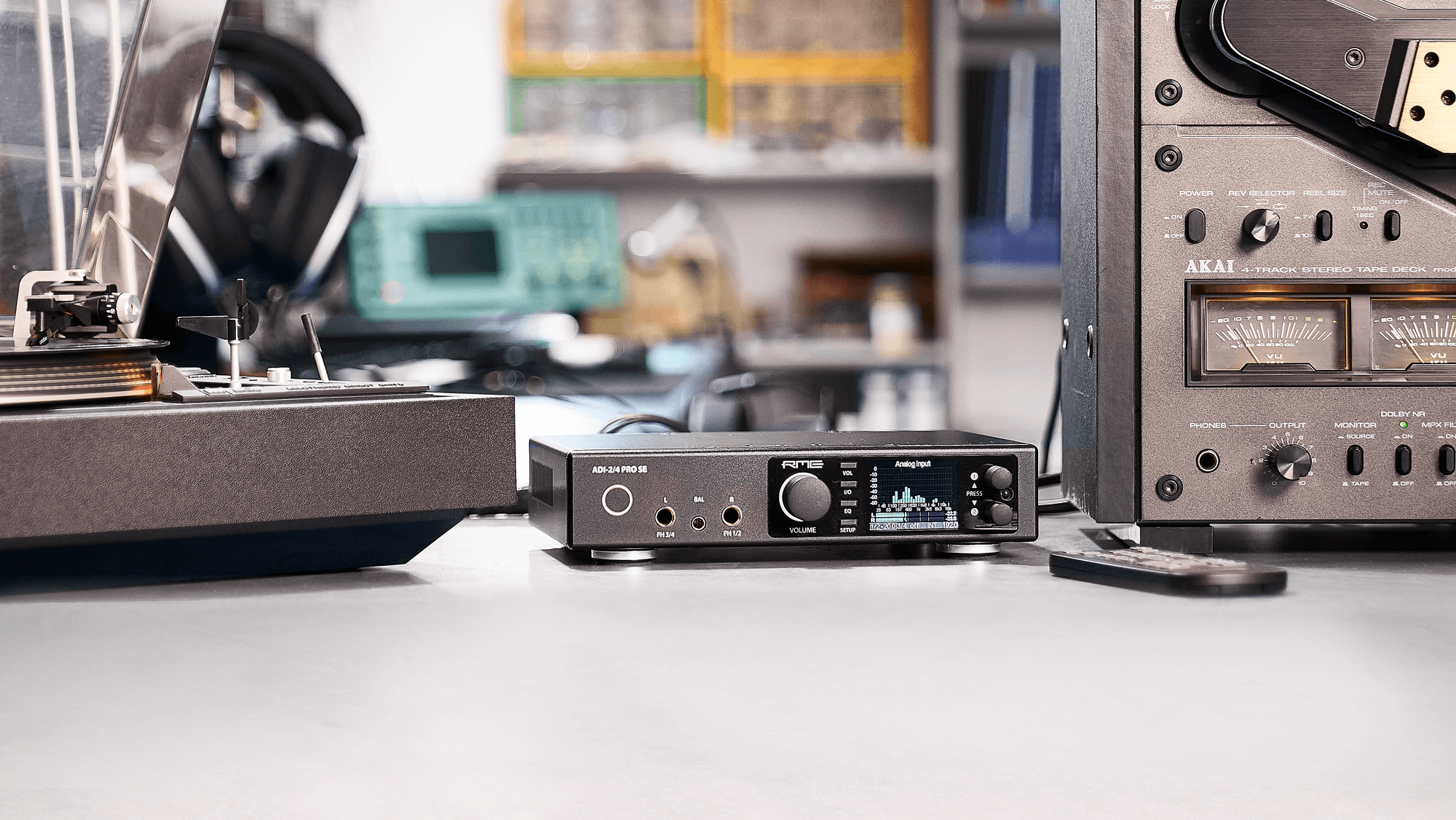
Even more Flexible and Powerful
The new Trigger Out socket provides a 12 V switching signal via 3.5 mm mono jack plug, which can be used e.g. to switch power amps with Trigger In on and off together with the ADI-2/4 Pro.
In order to make operating the ADI-2/4 Pro SE as flexible as possible, the unit has a universal DC input socket, accepting voltages from 9.5 Volts up to 15 Volts. An internal switching regulator of the latest technology with high efficiency (> 90%) prevents internal hum noise by operating above audible frequencies. Internally the switching regulator is followed by standard linear regulators, followed by super low-noise linear regulators. Therefore the ADI-2/4 Pro SE achieves its technical specs even with less optimal power supplies. Or in other words: the choice of power supply is not critical.
Shortly after the release of the original ADI-2 Pro we received many requests for digitizing vinyl records. Thanks to MM (Moving Magnet) compatibility, the ADI-2/4 Pro SE does not require an external preamplifier anymore and can directly be connected to turntables. It has suitable input impedance, RIAA equalization, and the necessary preamplification.
Extended Multi-Remote Support (MRC)
The ADI-2/4 Pro remote control provides buttons for standby on/off, volume, balance, bass and treble, input selection (optical, coaxial, USB), mute, on/off loudness, bass/treble and EQ. In addition, there are four programmable buttons that provide access to 52 different functions and commands for maximum flexibility. There is no other converter or comparable device with such a sophisticated, easy to use and at the same time versatile remote control . To control the ADI-2/4 Pro SE code table 3 needs to be activated so that the SEL LED lights up in red color.
More Outstanding Features
SteadyClock FS - Reference class Digital Clocking
Excellent performance in all clock modes and High Quality Analog Conversion to hear your mix as it is, with lowest jitter and highest jitter immunity.
DigiCheck - The Secret Weapon of High Resolution Audio Measurements
RME Audio interfaces not only provide you with a professional digital audio interface, but also with a free available software tool: DigiCheck, for metering, testing, measuring and analyzing digital audio streams.
ADI-2 Remote
The ADI-2 Remote software controller offers a seamless and intuitive interface for managing various parameters of the ADI- 2 series devices.
Accessories
- MRC - Multi-Remote-Control (included)
- 40 Watts SMPS with IEC socket (included)
- BO968 Digital breakout cable (9-pin D-sub to 2 x XLR and 2 x RCA) (included)
Specs
ADI-2/4 Pro SE
Analog Inputs
XLR/TRS
- Input: XLR and 6.3 mm TRS jack, servo-balanced
- Input impedance @ 1 kHz, balanced: 90 kOhm, unbalanced: 45 kOhm
- Input sensitivity switchable +24 dBu, +19 dBu, +13 dBu, +7 dBu, +1 dBu @ 0 dBFS
- Digital Trim Gain range: 0 dB up to +6 dB, in steps of 0.5 dB
- Signal to Noise ratio (SNR) @ +13/19/24 dBu: >120 dB (AES17), >123 dBA
- Signal to Noise ratio (SNR) @ +7/+1 dBu: >120 dB (AES17), 123 dBA
- Frequency response* @ 44.1 kHz, -0.1 dB: 0.4 Hz – 20.4 kHz
- Frequency response* @ 96 kHz, -0.5 dB: 0.2 Hz – 45.5 kHz
- Frequency response* @ 192 kHz, -1 dB: 0.15 Hz – 90.9 kHz
- Frequency response* @ 384 kHz, -1 dB: 0.15 Hz – 182 kHz
- Frequency response* @ 768 kHz, -1 dB: 0.15 Hz – 348 kHz
- THD @ -0.5 dBFS: > -130 dB, 0.0000316 %
- THD+N @ -0.5 dBFS: -119 dB, 0.000112 %
- Channel separation: > 130 dB @ 1 kHz
* DC Filter None. With Filter RME @ -1 dB: < 0,5 Hz
RIAA Mode via TS
- RIAA deviation 20 Hz – 20 kHz: < ±0.05 dB
- Input impedance: 45 kOhm @ 1 kHz, input capacitance 150 pF
- Sensitivity: +14 dB: 20 mV, +20 dB: 10 mV, +26 dB: 5 mV
- Sensitivity: +32 dB 2.5 mV, +38 dB: 1.25 mV
- Additional 0 to +6 dB Gain in steps of 0.5 dB via Trim Gain
- Maximum input level @ +14 dB: 114 mV, -16.6 dBu
- Maximum input level @ +20 dB: 57 mV, -22.6 dBu
- Maximum input level @ +26 dB: 28.4 mV, -28.7 dBu
- Maximum input level @ +32 dB: 14.3 mV, -34.7 dBu
- Maximum input level @ +38 dB: 7.2 mV, -40.6 dBu
- Digital headroom in all Gains, related to sensitivity: 15 dB
- Signal to Noise Ratio (SNR), 20 Hz-20 kHz, +14/20 dB Gain: 88 dB, 92 dBA
- Signal to Noise Ratio (SNR), 20 Hz-20 kHz, +26 dB Gain: 80.5 dB, 85 dBA
- Signal to Noise Ratio (SNR), 20 Hz-20 kHz, +32 dB Gain: 74 dB, 78.5 dBA
- Signal to Noise Ratio (SNR), 20 Hz-20 kHz, +38 dB Gain: 68 dB, 73 dBA
- THD+N, 20 Hz-20 kHz, +14/+20 dB: -88 dB, 0.004 %
- THD+N, 20 Hz-20 kHz, +26 dB: -81.5 dB, 0.0084 %
- THD+N, 20 Hz-20 kHz, +32 dB: -74 dB, 0.019 %
- THD+N, 20 Hz-20 kHz, +38 dB: -69 dB, 0.035 %
Analog Outputs
1/2 XLR
- Maximum Output Level: +26.5 dBu @ 0 dBFS
- Output level switchable +24 dBu, +19 dBu, +13 dBu, +7 dBu, +1 dBu @ 0 dBFS
- Signal to Noise ratio (SNR) @ +7/+13/19/24 dBu: 120 dB (AES17), 123 dBA
- Signal to Noise ratio (SNR) @ +1 dBu: 119 dB (AES17), 120 dBA
- Frequency response @ 44.1 kHz, -0.1 dB: 0 Hz – 21 kHz
- Frequency response @ 96 kHz, -0.5 dB: 0 Hz – 44.9 kHz
- Frequency response @ 192 kHz, -1 dB: 0 Hz – 90 kHz
- Frequency response @ 384 kHz, -1 dB: 0 Hz – 181 kHz
- Frequency response @ 768 kHz, -3 dB: 0 Hz – 285 kHz
- THD @ 0 dBFS: < -120 dB, 0.0001 %
- THD+N @ 0 dBFS: -116 dB, 0.00016 %
- Channel separation: > 130 dB
- Output impedance @ 1 kHz @ +24/+19/+13 dBu: 213 Ohm
- Output impedance @ 1 kHz @ +7/+1 dBu: 113 Ohm
1/2 TS (rear)
As output XLR, but:
- Output: 6.3 mm TRS jack, impedance-balanced
- Maximum output level: +21.5 dBu @ 0 dBFS
- Signal to Noise ratio (SNR) @ +19/13 dBu: 120 dB (AES17), 123 dBA
- Signal to Noise ratio (SNR) @ +7 dBu: 119 dB (AES17), 121 dBA
- Signal to Noise ratio (SNR) @ +1 dBu: 118 dB (AES17), 118 dBA
- Output impedance @ 1 kHz: balanced 213 Ohm, unbalanced 106 Ohm
Phones 1/2, Phones 3/4
As Output 1/2 TRS, but:
- Output: 6.3 mm TRS stereo jack, unbalanced
- Maximum output level: +21.5 dBu @ 0 dBFS
- Output impedance: 0.1 Ohm
- Signal to Noise ratio (SNR) @ +19 dBu (Hi-Power): 120 dB (AES17), 122 dBA
- Signal to Noise ratio (SNR) @ +7 dBu (Lo-Power): 119 dB (AES17), 121 dBA
- Signal to Noise ratio (SNR) @ +1 dBu (IEM): 118 dB (AES17), 120 dBA
- Output level at 0 dBFS, Ref Level +19 dBu, load 100 Ohm or up: +21.5 dBu (9.2 V)
- Minimum load impedance IEM @ +1 dBu: 4 Ohm
- Minimum load impedance Lo-Power @ +7 dBu: 8 Ohm
- Minimum load impedance Hi-Power @ +19 dBu: 24 Ohm
- THD @ +20 dBu, 32 Ohm load (1.9 Watts): -124 dB, 0.000057 %
- THD+N @ + 20 dBu, 32 Ohm load (1.9 Watts): -118 dB, 0.00011 %
- Max power @ 0.001% THD: 2.1 W per channel
- Channel separation 20 Hz – 20 kHz: 80 dB @ 32 Ohm
Balanced Phones mode
As before, but:
- Maximum output level: +27.5 dBu (18.4 V) @ 0 dBFS
- Output levels switchable: IEM +7 dBu, Lo-Power +13 dBu, Hi-Power +25 dBu
- Output levels switchable: IEM 1.73 V, Lo-Power 3.46 V, Hi-Power 13.8 V
- Output impedance: 0.2 Ohm Signal to Noise ratio (SNR) @ +25 dBu: 120 dB (AES17), 122 dBA
- Signal to Noise ratio (SNR) @ +13 / +7 dBu: 119 dB (AES17), 121 dBA
- Minimum load impedance IEM @ +7 dBu: 8 Ohm
- Minimum load impedance Lo-Power @ +13 dBu: 12 Ohm
- Minimum load impedance i Hi-Power @ +25 dBu: 40 Ohm
- Max power @ 0.001% THD: 4 W per channel Channel separation: > 130 dB @ 1 kHz
Digital Inputs
General
- Lock Range: 28 kHz – 200 kHz
- Jitter suppression: > 50 dB (> 1 Hz)
- Accepts Consumer and Professional format
AES/EBU
- 1 x XLR, transformer-balanced, galvanically isolated, according to AES3-1992
- Input sensitivity 1.0 Vpp
SPDIF coaxial
- 1 x RCA, transformer-balanced, according to IEC 60958
- High-sensitivity input stage (< 0.3 Vpp)
- AES/EBU compatible (AES3-1992)
SPDIF optical
- 1 x optical, according to IEC 60958
- ADAT compatible
Digital Outputs
AES/EBU
- 1 x XLR, transformer-balanced, galvanically isolated, according to AES3-1992
- Output level 2.7 Vpp
- Format Professional according to AES3-1992 Amendment 4
- Single Wire mode, sample rate 28 kHz up to 200 kHz
SPDIF coaxial
- 1 x RCA, according to IEC 60958
- Output level 0.75 Vpp
- Format Consumer SPDIF according to IEC 60958
- Single Wire mode, sample rate 28 kHz up to 200 kHz
SPDIF optical
- 1 x optical, according to IEC 60958
- Format Consumer (SPDIF) according to IEC 60958
- Sample rate 28 kHz up to 200 kHz
Digital
- Clocks: Internal, AES In, SPDIF In, ADAT In
- Jitter suppression of external clocks: > 50 dB (> 1 Hz)
- Effective clock jitter influence on AD and DA conversion: near zero
- PLL ensures zero dropout, even at more than 100 ns jitter
- Additional Digital Bitclock PLL for trouble-free varispeed ADAT operation
- Supported sample rates for external clocks: 32 kHz up to 200
- Internally supported sample rates: 44.1 kHz up to 768 kHz
General
- Included power supply: external switching PSU, 100 - 240 V AC, 3.3 A, 40 Watts
- Standby power consumption DC 12 V: 170 mW
- Standby power consumption AC 230 V: 280 mW
- Idle power consumption: 14 Watts, Max. power consumption: 30 Watts
- Idle current at 12 V: 1.16 A
- Dimensions (WxHxD): 215 x 44 x 160 mm (8.5" x 1.73" x 6.3")
- Weight: 1.2 kg ( 2.2 lbs)
- Temperature range: +5° up to +40° Celsius (41° F up to 112°F)
- Relative humidity: < 75%, non condensing
All specifications are subject to change without notice.
Drivers
ADI-2/4 Pro SE
Update to firmware: (* latest change)
MADIface XT: USB 191 PCIe 56 DSP 42
MADIface XT II: USB 3/2 321, DSP 59, CC 11*
MADIface USB: 25 (6), 102 (7)
MADIface Pro: 73
OctaMic XTC: 47/26
ADI-2 Pro series (6): FPGA 267, DSP 128
ADI-2 Pro series (7): FPGA 412, DSP 128
ADI-2 DAC series: FPGA 81, DSP 62
ADI-2/4 Pro SE: FPGA 73, DSP 40
ADI-2/4 Pro SE: FPGA 210, DSP 40
UFX II: USB 26 DSP 28 CC 15 (A), USB 115 DSP 28 CC 112 (E), USB 206 DSP 28 CC 208 (7)
Fireface UFX III: USB 20 DSP 23 CC 44
UFX+: USB 55 DSP 59 Thunderbolt 112 (A), USB 72 DSP 60 Thunderbolt 167 (E)
Digiface USB: 18 (X), 35 (G)
Digiface AVB: 261
Digiface Dante: 57
Digiface Ravenna: 55
Digiface AES: USB 47 MCU 17 CC 11
USB I/O: USB 6, CC 4
Update to version: (*latest changes)
MADIface XT: USB 3/2 191, PCIe 56, DSP 42
MADIface XT II: USB 3/2 321, DSP 59, CC 11*
MADIface USB, Hw Rev 6: 25
MADIface USB, Hw Rev 7: 102
MADIface Pro: 73
OctaMic XTC: USB 47, DSP 26
ADI-2/4 Pro SE: FPGA 72, DSP 40
ADI-2/4 Pro SE: FPGA 210, DSP 40
ADI-2 Pro Series: FPGA 267, DSP 128
ADI-2 Pro Series: FPGA 412, DSP 128
ADI-2 DAC: FPGA 81, DSP 62
Digiface USB, Hw Rev X: 18
Digiface USB, Hw Rev G: 35
Fireface UFX II, Hw Rev A: USB 26, DSP 28, CC 15
Fireface UFX II, Hw Rev E: USB 115, DSP 28, CC 112
Fireface UFX II, Hw Rev 7: USB 206, DSP 28, CC 208
Fireface UFX III: USB 20 DSP 23 CC 44
Digiface Dante: 57
Digiface Ravenna: 55
Digiface AES: USB 47, MCU 17, CC 11
USB I/O: USB 6, CC 4
Update to version: (*latest changes)
MADIface XT: USB 3/2 191, PCIe 56, DSP 42
MADIface XT II: USB 3/2 321, DSP 59, CC 11*
MADIface USB, Hw Rev 6: 25
MADIface USB, Hw Rev 7: 102
MADIface Pro: 73
OctaMic XTC: USB 47, DSP 26
ADI-2/4 Pro SE: FPGA 72, DSP 40
ADI-2/4 Pro SE: FPGA 210, DSP 40
ADI-2 Pro Series: FPGA 267, DSP 128
ADI-2 Pro Series: FPGA 412, DSP 128
ADI-2 DAC: FPGA 81, DSP 62
Digiface USB, Hw Rev X: 18
Digiface USB, Hw Rev G: 35
Fireface UFX II, Hw Rev A: USB 26, DSP 28, CC 15
Fireface UFX II, Hw Rev E: USB 115, DSP 28, CC 112
Fireface UFX II, Hw Rev 7: USB 206, DSP 28, CC 208
Fireface UFX III: USB 20 DSP 23 CC 44
Digiface Dante: 57
Digiface Ravenna: 55
Digiface AES: USB 47, MCU 17, CC 11
USB I/O: USB 6, CC 4
Update to firmware: (* latest change)
MADIface XT: USB 191 PCIe 56 DSP 42
MADIface XT II: USB 3/2 321, DSP 59, CC 11*
MADIface USB: 25 (6), 102 (7)
MADIface Pro: 73
OctaMic XTC: 47/26
ADI-2 Pro series (6): FPGA 267, DSP 128
ADI-2 Pro series (7): FPGA 412, DSP 128
ADI-2 DAC series: FPGA 81, DSP 62
ADI-2/4 Pro SE: FPGA 73, DSP 40
ADI-2/4 Pro SE: FPGA 210, DSP 40
UFX II: USB 26 DSP 28 CC 15 (A), USB 115 DSP 28 CC 112 (E), USB 206 DSP 28 CC 208 (7)
Fireface UFX III: USB 20 DSP 23 CC 44
UFX+: USB 55 DSP 59 Thunderbolt 112 (A), USB 72 DSP 60 Thunderbolt 167 (E)
Digiface USB: 18 (X), 35 (G)
Digiface AVB: 261
Digiface Dante: 57
Digiface Ravenna: 55
Digiface AES: USB 47 MCU 17 CC 11
USB I/O: USB 6, CC 4
Driver for Windows 10 / 11, Intel x64 and Arm, version 1.0. Supports Intel Windows 10 or up 64 bit, and Windows 11 Arm systems, with both WDM and ASIO. Updated installer. See readme for details.
Version 0.9845, Windows 8 and up. Last version to support Windows 32 bit.
Driver for Windows 10 / 11, Intel x64 and Arm, version 1.0. Supports Intel Windows 10 or up 64 bit, and Windows 11 Arm systems, with both WDM and ASIO. Updated installer. See readme for details.
Version 0.9845, Windows 8 and up. Last version to support Windows 32 bit.
Version 0.9827, last driver version for Windows 7.
Version 0.9845, Windows 8 and up. Last version to support Windows 32 bit.
Universal binary, runs natively on Intel and Mx machines. DigiCheck NG V 0.92 requires macOS 10.13 (High Sierra) or up.
Differences to v 4.53: EBU R-128 Meter. Surround Audio Scope with ITU weighting. Simultaneous usage of multiple cards in all functions. Displays fully configurable (e.g. channel selection). Multichannel Level Meter freely configurable. MMCSS for Vista. Many improvements on surface and internal operation. Supports all current interfaces plus DIGI 9636/52. DIGI32 series and DIGI96 series are no longer supported. (10/05/2020).
V596 adds compatibilty for HDSPe MADI FX and XT with DK firmware.
DigiCheck NG V 0.92 requires a Direct3D 12 capable graphics card and Windows 10 or up.
DigiCheck NG V 0.92 requires a Direct3D 12 capable graphics card and Windows 10 or up.
Remote, backup and editing app for the ADI-2 series for macOS, v 2.1. Requires latest firmware update!
For developers: the MIDI protocol as used in the ADI-2 Remote. This is NOT an app!
For developers: the MIDI protocol as used in the ADI-2 Remote. This is NOT an app!
Remote, backup and editing app for the ADI-2 series for Windows, v 2.1. Requires latest firmware update, and MADIface series USB driver 0.9827 or higher!
For developers: the MIDI protocol as used in the ADI-2 Remote. This is NOT an app!
Remote, backup and editing app for the ADI-2 series for Windows, v 2.1. Requires latest firmware update, and MADIface series USB driver 0.9827 or higher!
For developers: the MIDI protocol as used in the ADI-2 Remote. This is NOT an app!
For developers: the MIDI protocol as used in the ADI-2 Remote. This is NOT an app!
For developers: the MIDI protocol as used in the ADI-2 Remote. This is NOT an app!
For developers: the MIDI protocol as used in the ADI-2 Remote. This is NOT an app!
For developers: the MIDI protocol as used in the ADI-2 Remote. This is NOT an app!
Manuals
ADI-2/4 Pro SE
ADI-2 Remote manual, version 2.0, 03/2024
ADI-2/4 Pro SE manual, version 1.3, 11/2023
